Elizabeth Shoaf: ‘Girl in the Bunker’ Saves Herself with a Text
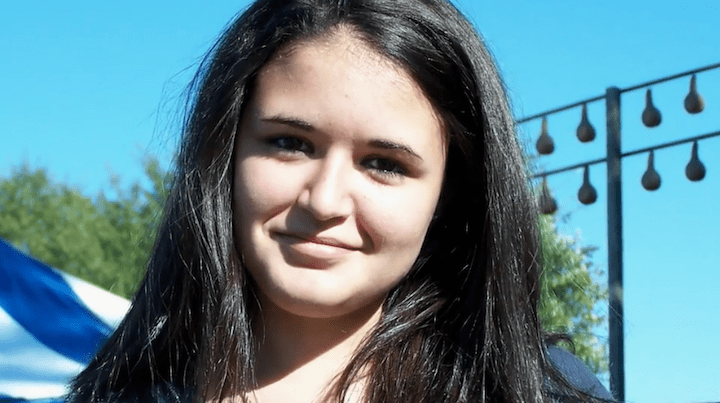
An undated photo of Elizabeth Shoaf before she was kidnapped and held in a bunker by Vinson Filyaw for 10 days. (Source)
Updated August 9, 2024
May 1, 2023 ~ By Shari Rose
Trapped in a bunker, 14-year-old Elizabeth Shoaf managed to secretly send her mother a text from her kidnapper’s phone and initiate her own rescue
Elizabeth Shoaf had just entered high school when she was kidnapped and held captive in an underground bunker by a serial sexual predator named Vinson Filyaw. In spite of the traumatic abuse she endured over the following 10 days, she found a way to secretly text her mom and guide authorities to the bunker’s location. Shoaf’s tenacity to stay alive and surreptitiously seek help in the face of unspeakable evil is the true story of how this “girl in the bunker” ultimately saved herself.
- Elizabeth Shoaf’s Life Before the Kidnapping
- Filyaw Abducts & Imprisons Shoaf in Bunker
- The Shoaf Family Searches For Elizabeth
- The Girl in the Bunker Continues to Survive
- Searches for the Missing Girl Grow More Desperate
- Shoaf Attempts to Text Her Mother
- Madeline Receives a Text From Her Daughter
- Shoaf Convinces Filyaw to Flee the Bunker
- Police Arrest Vinson Filyaw in ‘Girl in the Bunker’ Case
- Elizabeth Shoaf Now
Elizabeth Shoaf’s Life Before the Kidnapping
Shoaf grew up in a small, rural South Carolina town with her parents and two siblings. A community of just 7,000 people, Lugoff was home to large, undeveloped forests that permeated throughout the town for miles and miles. Elizabeth Shoaf’s home was partially surrounded by a dense tree line that gave way to large swaths of wilderness.
The middle child of the family, Shoaf was a 9th grader in high school. It was an exciting, albeit nerve-wracking time for the teenager: “I’d just started dating my high school sweetheart, and things just started looking good to me,” she recalled in the 2018 crime documentary, “Elizabeth Shoaf: The Girl in a Bunker.”
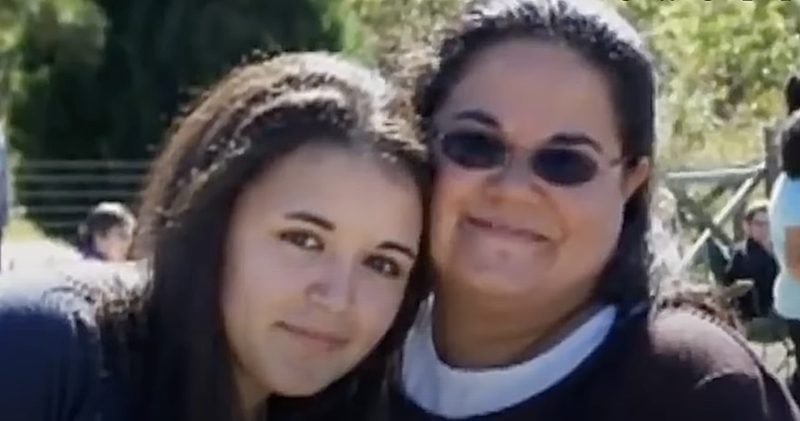
Elizabeth and her mother, Madeline, in a family photo. (Source)
Like most students in Lugoff, Shoaf took the bus to and from school everyday. The bus stop was just .25 miles from her home at the edge of the wood. She and her younger brother, Donnie, were taught to come straight home from the bus and do their homework before their parents got home from work.
On September 6, 2006, Shoaf got off the bus with a handful of other students and began to walk home. One of the kid’s older brothers pulled up in his car and offered to give everyone a ride. Because she was already so close to home, Shoaf was the only teen who declined the offer.
She walked alone on the country road after the other students piled into the car. That was the last time anyone saw Shoaf for the next 10 days.
- More stories: How Abby Hernandez Convinced Her Kidnapper to Let Her Go
- More stories: Enietra Washington: Only Confirmed Grim Sleeper Survivor
- More stories: Jennifer Schuett: A Survivor’s 19-Year Journey to Justice
Filyaw Abducts & Imprisons Shoaf in Bunker
Less than half an acre from her home, Elizabeth Shoaf was approached by 36-year-old Vinson Filyaw.
“I was just walking down my driveway, and heard some shuffling in the leaves to my right, she recalled. “And as I looked in that direction, [Filyaw] approached me and stated that he was with the Kershaw County Sheriff’s Department. He told me I was under arrest.”
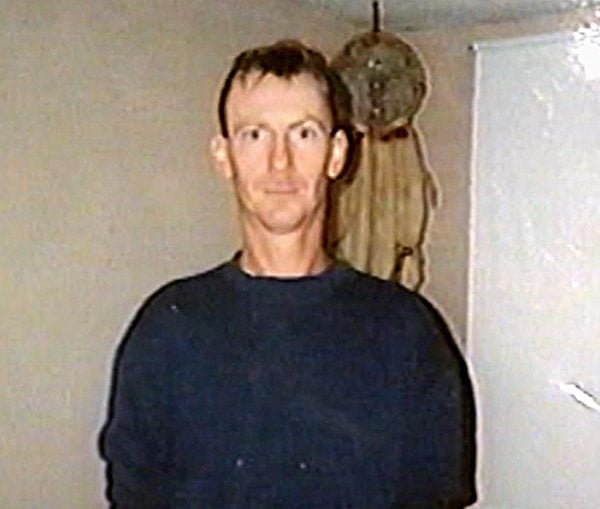
Elizabeth Shoaf’s abductor, Vinson Filyaw, in an undated photo. (Source)
Wearing camouflage pants and a green shirt, Filyaw showed Shoaf a fake sheriff’s badge and told her that marijuana had been found on her family’s property. He said that her 12-year-old brother was already in custody, and she needed to come with him to answer some questions.
Initially, Shoaf believed Filyaw because she wanted to help her brother, Donnie.
“I’ve always been the bigger sister, protective over him. I wanted to go and make sure he was okay,” she said.
Filyaw handcuffed the teenager, and then did something that was Shoaf’s first sign that all was not as it seemed. He tied a small box around her neck and told her it was a bomb.
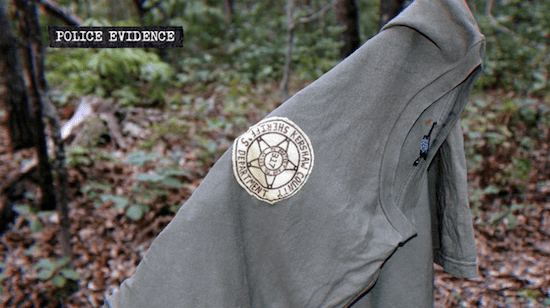
Photo of the shirt that Filyaw wore when posing as a sheriff’s deputy. (Source)
Alarmed, but complying with his orders, she walked with the man away from the road and through the woods. So close to home, she could see her family’s property as they walked.
“I could see my house and everything right through the trees,” Shoaf recounted. “I could see Stewart and Boomer, our dogs barking at us.”
She started to ask questions. Where are we going? Where’s my brother? Filyaw assured her that Donnie was close by, and they kept walking.
“I knew something was fishy,” she said. “I’m alone with this man in the woods, handcuffed.”
Filyaw suddenly stopped walking, and informed Shoaf that he had kidnapped her. The man then brushed aside some leaves and foliage to reveal a door in the forest floor. He uncovered a pitch-black, underground bunker and ordered the 14-year-old girl to get in.
“I figured that was my grave or what, but he told me to climb on in,” she said. “All that’s running through my mind is, ‘What is he going to do?’”
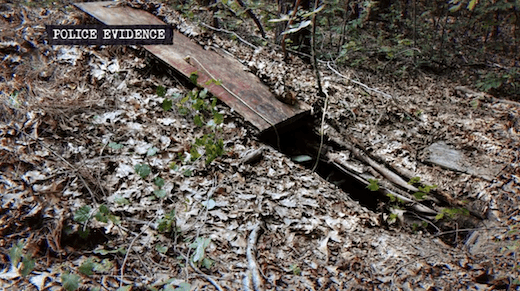
Exterior of the bunker where Shoaf was held for 10 days. (Source)
Filyaw padlocked the door shut and immediately sexually assaulted Shoaf. For the next 10 days, she remained a prisoner in that tiny, underground bunker, 8 feet below the earth.
“Close to home, you’d think it wouldn’t happen to you, but I was in the wrong place at the wrong time,” she said.
The Shoaf Family Searches For Elizabeth
When Elizabeth’s mother, Madeline Shoaf, learned that her daughter had not returned home from school that day, she knew something was wrong.
Donnie told her over the phone that his older sister hadn’t come home yet. Madeline then called Elizabeth’s friends, but no one had seen her since she got off the bus that afternoon.
By the early evening, many of Elizabeth Shoaf’s extended family members had come to the home and began combing the woods in search of her. Her parents called the Kershaw County Sheriff’s Department and filed a missing person report that night. Police initially believed Elizabeth to be a runaway, but her parents knew she wasn’t.
The following morning, the sheriff’s department used a helicopter to scope the woods and look for signs of Shoaf. Law enforcement, family members, and volunteers from the town searched for hours, but found nothing. In the underground bunker with her kidnapper, Shoaf could hear footsteps pass right over her.
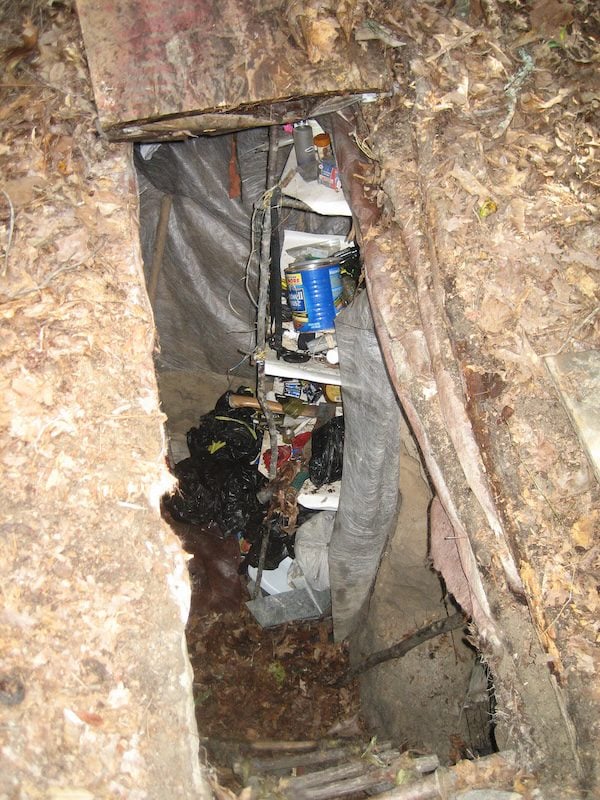
The trap door leading to Filyaw’s bunker, near Lugoff. (AP Photo/Jim Davenport)
“We heard helicopters,” she said. “We would hear footsteps or see like a shadow across the door.”
But she could not make a sound.
“[Filyaw] pretty much would put his hand around my mouth, or tell me to shut up, hold the gun to my head and tell me if I make a sound, he was going to shoot me,” Shoaf recounted.
The bunker was less than a mile from her home, but it was so well hidden that her would-be rescuers kept passing right over her. Eventually, footsteps and sounds of the helicopter stopped. And silence returned again as the girl in the bunker was once again alone with her captor.
- More stories: Kathy Kleiner & Karen Chandler: Ted Bundy Survivors at Chi Omega
- More stories: A Hitman Came for Susan Kuhnhausen – He Didn’t Survive
- Read all Survivor Stories at Blurred Bylines
The Girl in the Bunker Continues to Survive
During her 10 days of imprisonment, Elizabeth Shoaf endured unconscionable sexual abuse at the hands of Vinson Filyaw. She was chained to a makeshift bed and experienced sexual assaults up to five times a day.
“He ended up chaining me to a large chain link right above the bed to where I couldn’t leave the bed, I was just chained to the ceiling,” she described in a 2018 crime special about her survival.
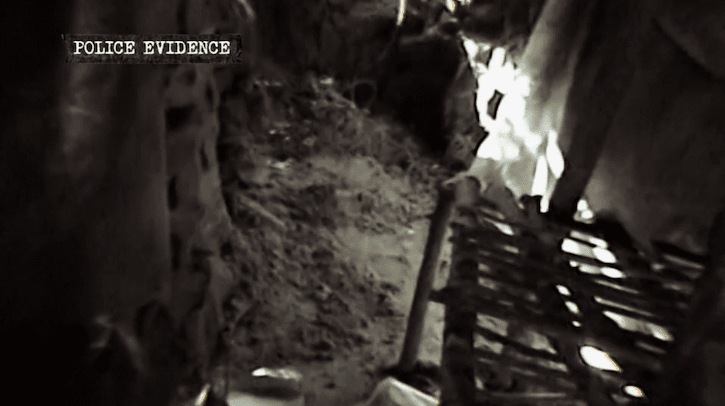
Police evidence of Filyaw’s bunker after his arrest. (Source)
Shoaf recalled the disgusting nature of her abductor’s bunker. The underground structure was filled with trash and its toilet was nothing more than a broken patio chair with a bucket. Everything was covered in dirt and the bed was made with bunches of sticks tied together.
There were also stashes of bomb-making equipment scattered throughout. Filyaw had a plan, and made sure Shoaf knew about it too.
“He had told me he planted multiple bombs around the bunker and that he had the idea that he would leave me in there, lure the cops to find me, and blow the whole bunker up,” she said.
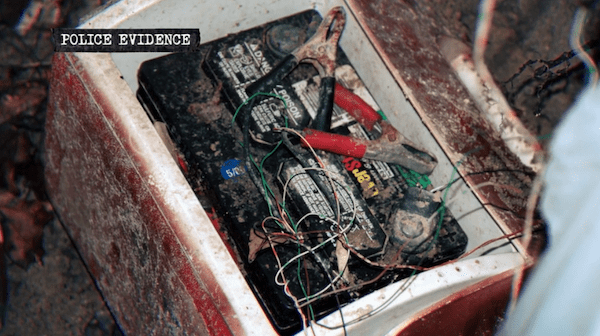
Materials that appear to be bomb-making equipment found on Filyaw’s property. (Source)
Filyaw had been on the run from the Kershaw County Sheriff’s Department for the past year. After it was discovered he was sexually abusing his girlfriend’s 12-year-old daughter, Filyaw successfully avoided arrest by hiding in different bunkers he had built throughout the woods.
Furious at law enforcement for daring to bring him to justice, he hatched a scheme to kill as many sheriff’s deputies as he could – and he wanted a young girl like Shoaf to be the bait that drew them into his booby-trapped bunker.
Aware of his plans, Elizabeth Shoaf realized she needed to figure out how to escape her kidnapper before his long-awaited scheme came to fruition.
- More stories: Jennifer Holliday: Shooting Survivor in East Texas
- More stories: How Mary Vincent Survived Lawrence Singleton
Searches for the Missing Girl Grow More Desperate
Back at home, the Shoaf family and sheriff’s department worked tirelessly to find her. Thousands of fliers were plastered around Lugoff, Elgin, and other nearby towns. Hundreds of people volunteered each day to search the woods for any sign of the missing girl.
Local news covered her disappearance, and law enforcement received hundreds of tips. Elizabeth’s mother, Madeline, recalled the stress of chasing down tips: “You hear of reports from people. You know, ‘Oh, they found a body in this county. Or they found a body in that county.’ And you’re just praying, you know, that it’s not her. I hated it for the person that actually passed away. But just thank God it wasn’t her.”
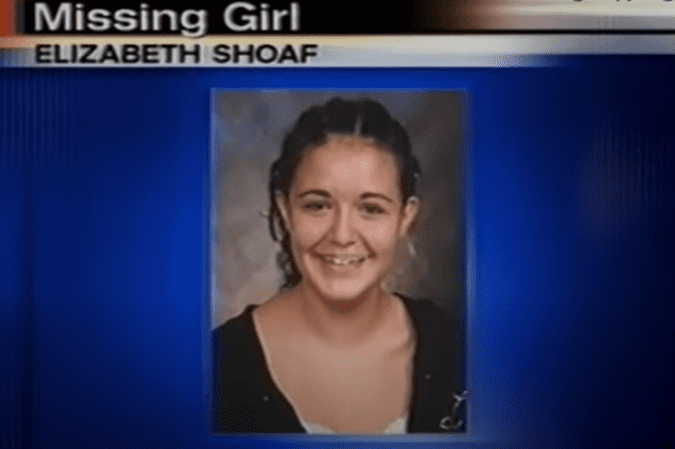
Local television news covers Elizabeth Shoaf’s disappearance in Lugoff, S.C. (Source)
Despite the widespread coverage and ongoing search parties, authorities had not a single clue into Elizabeth Shoaf’s disappearance. And to the disappointment of the Shoaf family, the Kershaw County Sheriff’s Department could not put out an Amber Alert. They had no vehicle, no suspect, no tangible details to share. The teenage girl somehow vanished in a quarter-mile space next to her family’s home.
But her parents kept searching. Her father, Don Shoaf, spent the days driving every square inch of road he could find.
“I don’t know how many miles I put on that 4-wheel,” Shoaf said in a 2008 interview with Dateline. “I mean I stayed gone until I couldn’t see any more, so I mean, you know and then we would connect here and there in the evenings and cry and do whatever.”
As the days passed by, the likelihood that Elizabeth Shoaf would be found alive became smaller and smaller. With each day she remained missing, sheriffs believed more and more they were searching for a body. But the 14-year-old girl was still alive, and closer than anyone would believe. She began to devise her own plan to signal to rescuers she was right there in that bunker, just 8 feet below the earth.
Shoaf Attempts to Text Her Mother
In the dark, dirty bunker, Shoaf worked to make Filyaw trust her and allow her more freedoms. She pretended to find him attractive and acted as though she wanted to be there with him.
“As the days went on, if I didn’t didn’t fight back or if I wasn’t as hesitant to him, he would be less violent with me,” she recounted. “Act like the rape was pleasurable, you know, say that you love him or whatever you can to just make things easier, I was going to do it.”
Shoaf’s strategy started to work. Filyaw allowed her to wear her clothes and unchained her at different times of the day, sometimes even while he was asleep.
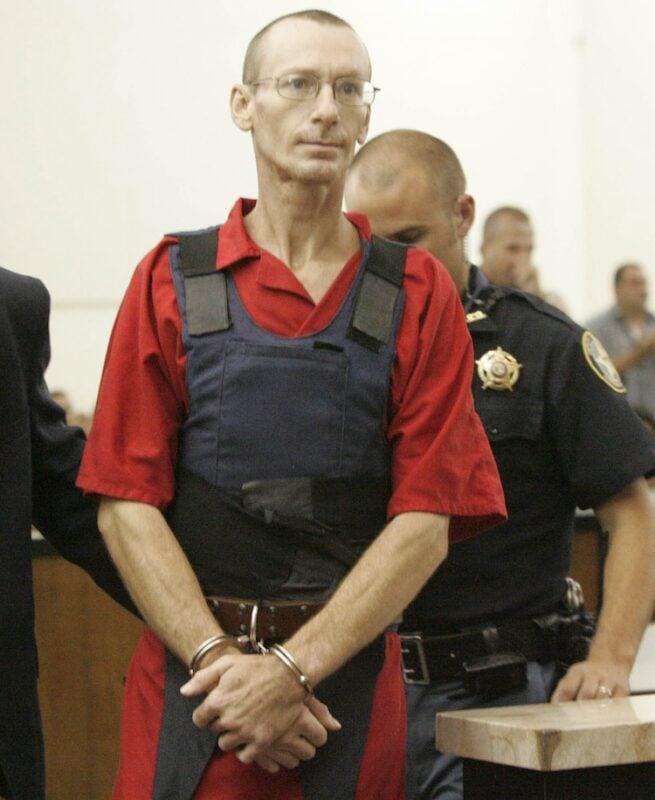
Vinson Filyaw appears during his bond hearing ahead of trial in this Sept. 18, 2006 photo, in Camden, SC. (AP Photo/Mary Ann Chastain, Pool)
One day, she found his gun in a holster. She decided to try and use it against her abductor.
While he slept, Shoaf pulled the weapon out and attempted to fire a shot at his temple. But the gun jammed.
As it turns out, the pistol was nothing more than a pellet gun. It would not have done the damage she needed it to, and the act could have easily angered Filyaw to the point of killing her.
“So, things kind of work out in their own way,” Shoaf concluded.
Because she had built trust with her captor, Filyaw eventually allowed her to play games on his phone. With no cell signal underground, the ‘girl in the bunker’ played simple games on the device to pass the time. At least, while Filyaw was awake.
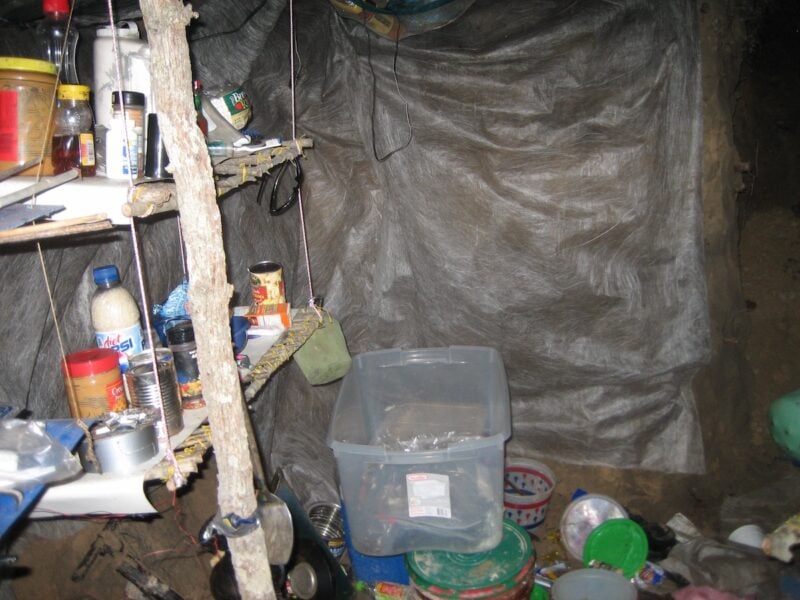
Jars and cans of food sit on shelves in Filyaw’s underground bunker. (AP Photo/Jim Davenport)
As her kidnapper slept, Elizabeth Shoaf attempted to send text messages to her mother. But the process was time-consuming.
“It was a basic, old-school cell phone,” she said. “When you text, you had to hit each individual number to the specific letter that you wanted. So creating the message took a lot of time. If he moved or shuffled, I had to hurry up and delete everything. But every time I would send the message, it said it failed.”
Still, Shoaf kept trying as the days persisted on. She held the phone up to the door of the bunker in hopes that a message would finally go through. Even so, each attempt was met with a message that the text failed to send.
But as luck or divine intervention would have it, a single text message made it through to her mother.
- More stories: How Tiffany Taylor Survived Serial Killer Khalil Wheeler-Weaver
- More stories: When Jennifer Morey Survived a Brutal Knife Attack
Madeline Receives a Text From Her Daughter
At home, Madeline Shoaf received a text from an unknown number. The message said it was her daughter, and she was in a hole.
“I was hysterical, yeah,” Madeline said. “I was in shock, too. Because I was just, like, ‘Oh my God, here’s what we’ve been waiting for. This is what we’ve been praying for, for all these days.’ Just to get one answer to where she was. And this was our answer.”
She said she knew it was her daughter because the text used the name, ‘Lizy.’
“I knew it was her. There was no doubt in my mind that it was anybody else because nobody else referred to her but her by that name,” Madeline Shoaf explained.
Authorities quickly traced the number to a nearby neighborhood, Charm Hill. And they discovered who the number belonged to: Vinson Filyaw, a suspect they had been searching for over the past year.

Interior view of the bunker shows mostly dirt and a makeshift bed made of sticks. (Source)
The Kershaw County Sheriff’s Department got a warrant to search Filyaw’s trailer home and they were horrified at what they discovered. Deputies say they found troves of pornography, drugs, and bomb-making equipment in the trailer. Then they uncovered a hole in the bedroom, one of Filyaw’s hiding places when they searched for him in the past.
Then-Sheriff Steve McCaskill described what he realized after searching the property in a 2008 interview.
“I guess that’s the sickest I was—I ever got. But we looked around, and put everything together: the facts that, you know, he abused alcohol and drugs, the fact that there was so much pornography in the house, the fact that this young lady was missing. You put them all three together and you think about what you’ve got. And it really—it really scared you.”
Throughout the search, deputies found more makeshift bunkers on the property and in the woods. They began to think that Elizabeth Shoaf was being held in one of these underground bunkers – if she was still alive.
“We felt [Filyaw] was progressing to become a serial killer,” McCaskill said. “I had absolutely no idea we would find this young lady alive, not with what I felt like was going on.”
With these discoveries, the sheriff made a controversial, even brazen, choice to flush Vilyaw out of his hiding place. Without informing Shoaf’s parents, the sheriff’s department shared the news that a text message from Elizabeth had been sent to her mother. The Shoaf family watched local news break the story in the evening.
Madeline Shoaf was furious with the release of this information. She recalled saying at the time, “‘They just killed my daughter!’”
Shoaf Convinces Filyaw to Flee the Bunker
Back in captivity, Elizabeth Shoaf had to contend with a furious Filyaw who learned via a battery-operated television in the bunker there had been a break in the case. Somehow, a text message was sent from his phone to her mother, and she had to speak carefully and maneuver her way out of being killed with this realization.
“He was completely upset,” she said. “And I would just deny everything. I told him that it wasn’t me, I didn’t send anything out. He could look through his phone because I deleted all the messages.”
With no evidence of the text she sent earlier, Filyaw could not prove she had managed to send a message out. Besides, he didn’t have time to be angry with her. Sounds of search helicopters returned as authorities narrowed down the approximate location of the bunker. With deputies closing in, Shoaf worked to convince her kidnapper that he needed to run.
“I told him that he needed to leave, that if he stayed there, the police were going to find him and I could always run away later on and meet up with him,” she explained.
- More stories: Teka Adams’ Survival After Fetal Abduction Attempt
- More stories: How Lisa McVey Survived an Abduction by Bobby Joe Long
After some time, Filyaw agreed that fleeing was his best option. Once the sounds of the search disappeared into the night, he exited the bunker and left Shoaf alone.
“I sat there for a minute, just kind of grasping onto everything and realizing I was there by myself, like he did leave,” she recounted.
The following morning, Shoaf left the bunker of her own free will.
“I didn’t know which way to walk, or what direction to go, so I decided to just yell,” Shoaf said. “See if maybe somebody could hear me.”
She yelled and yelled while trekking through the dense woods. Then, someone in the distance yelled her name back to her. It was a rescuer. After 10 days, Elizabeth Shoaf was found.
Police Arrest Vinson Filyaw in ‘Girl in the Bunker’ Case
The 14-year-old survivor was whisked away from the woods and taken to a nearby hospital. Elizabeth’s parents arrived shortly after.
“Mom came into the room and she was just bawling,” she said with a smile. “Definitely a moment I won’t forget.”
Madeline remembers the moment she was able to hold her daughter again.
“I just ran straight to her and gave her a hug and just told her ‘it’s going to be okay.’ It was the best feeling in the world to have her back,” she recalled.
While Elizabeth Shoaf recovered in the hospital, Vinson Filyaw was arrested one county over. He was charged with a litany of crimes, including kidnapping, 10 counts of first-degree criminal sexual assault (one charge for each day Shoaf was held), possession of explosives, and impersonating a police officer.
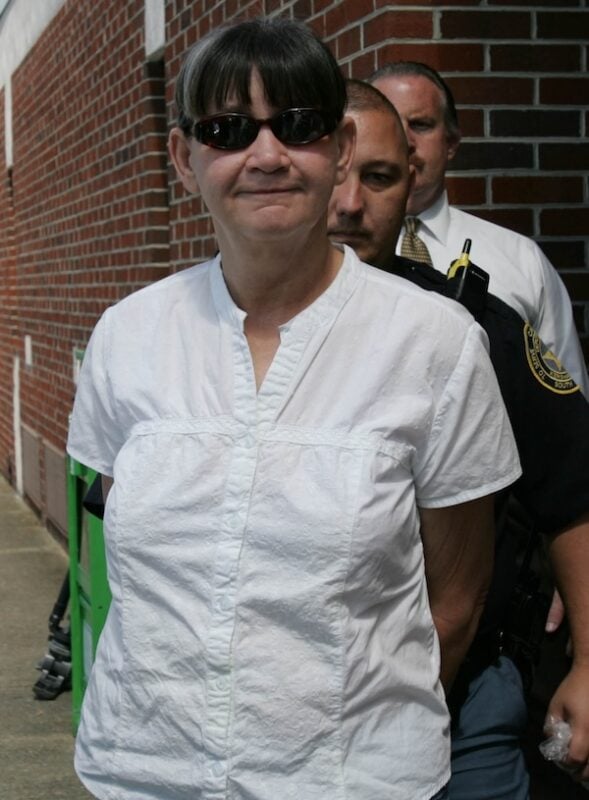
The mother of Vinson Filyaw, Ginger Nell Cobb, is escorted to by Kershaw County Sheriff Deputies after being arrested on Sept. 19, 2006, for adding and abetting a fugitive, her son. (AP Photo/Mary Ann Chastain)
And as her abuser awaited his fate in prison, Shoaf faced a difficult road to recovery as she attempted to return to her old life. In the weeks and months after coming home, the teenager contended with post traumatic stress disorder, anxiety, and depression. As much as she wanted to go back to normal, she learned there was no way to go back to how things were before.
“I was still in shock,” Shoaf said. “Like right after, I thought everything was peachy, like I was perfectly fine, I was going to move on with life. It took time for it to set in and actually hit me.”
She returned to school about a month and half after her captivity in the bunker. But Elizabeth Shoaf’s story was national news. Her fellow peers knew what happened to her, and that was a very isolating experience.
“I recalled walking into the cafeteria and everybody was just staring. Like everybody knew who I was and what happened to me,” she remembers.
And on top of it all, the upcoming trial weighed heavily on her mind. Shoaf considered whether she would testify against Filyaw in court.
“The idea of having to approach him again or seeing him again, you just don’t know how you’re going to really handle it until it happens,” Shoaf said.
- More stories: When Cindy Paulson Survived Serial Killer Robert Hansen
- More stories: Carol DaRonch’s Survival After Escaping Ted Bundy
But as she agonized over a looming trial that would no doubt re-traumatize her if she took the stand, Filyaw sealed his one fate in prison. He wrote a 120-page manuscript that explicitly detailed the horrific abuse he subjected to both Shoaf and the 12-year-old girl from previous years.
With this written confession in the hands of the prosecution, Filyaw pleaded guilty to all charges minutes before his trial was set to begin. Shoaf gave a statement through her lawyer at his sentencing.

Vinson Filyaw, center, listens as his sentence is passed by Judge G. Thomas Cooper on Wednesday, Sept. 19, 2007, at Beaufort County Courthouse in Beaufort, SC. Filyaw, who admitted to kidnapping Elizabeth Shoaf and holding her for more than a week in an underground bunker, was sentenced to 421 years in prison for a crime the judge called “repulsive.” (AP Photo/Bob Sofaly, Pool)
In September 2007, just over a year after the abduction, Filyaw was sentenced to 421 years in prison, the maximum punishment possible. On May 4, 2021, Vinson Filyaw died in jail at the age of 51.
Elizabeth Shoaf Now
Today, Shoaf works as a dental assistant in South Carolina while attending school at night to become a dental hygienist. She enjoys self-defense classes and spends time with her boyfriend and friends. But the journey to recovery is a hard one, and it’s a road she continues to travel on.
“It’s definitely difficult to just move on with life as if nothing happened,” she said. “Leaves or dirt can kind of throw like a flashback or a memory of me walking through the woods with him.”
As PTSD symptoms took hold in the weeks and months after her escape from the bunker, she described the feelings of hopelessness she felt as someone who endured so many horrors at a young age.
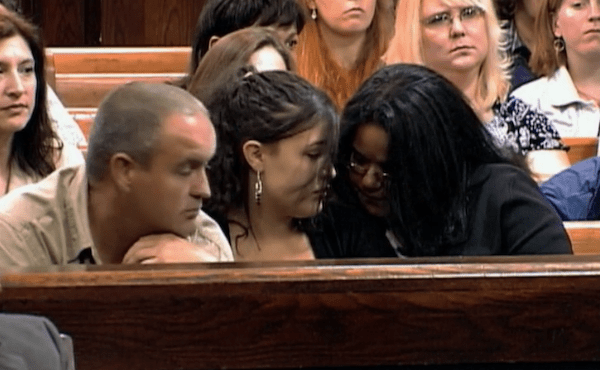
Shoaf sits between her parents while in court for Filyaw’s sentencing. (Source)
“You can’t always just stop thinking,” Elizabeth Shoaf explained. “When your mind starts racing and racing and racing, you start to feel like you’re getting out of control and you end up in a panic attack or you end up depressed, wishing none of this ever happened and you wouldn’t have to be doing this right now.”
But in spite of everything that she went through as the ‘girl in the bunker,’ Shoaf continues to move forward.
“You have to look at the whole picture itself. There’s way more good times than there are bad times. You just got to move on,” she said.
Shoaf continued: “You can truly make yourself happy if you keep on pushing. The dust may never settle, but I feel like I am at peace.”
- More stories: Kara Robinson’s Escape from a Serial Killer
- More stories: How Ellen Halbert Survived a ‘Ninja In The Attic’
- More stories: Whitney Bennett: A Teenage Survivor of Richard Ramirez





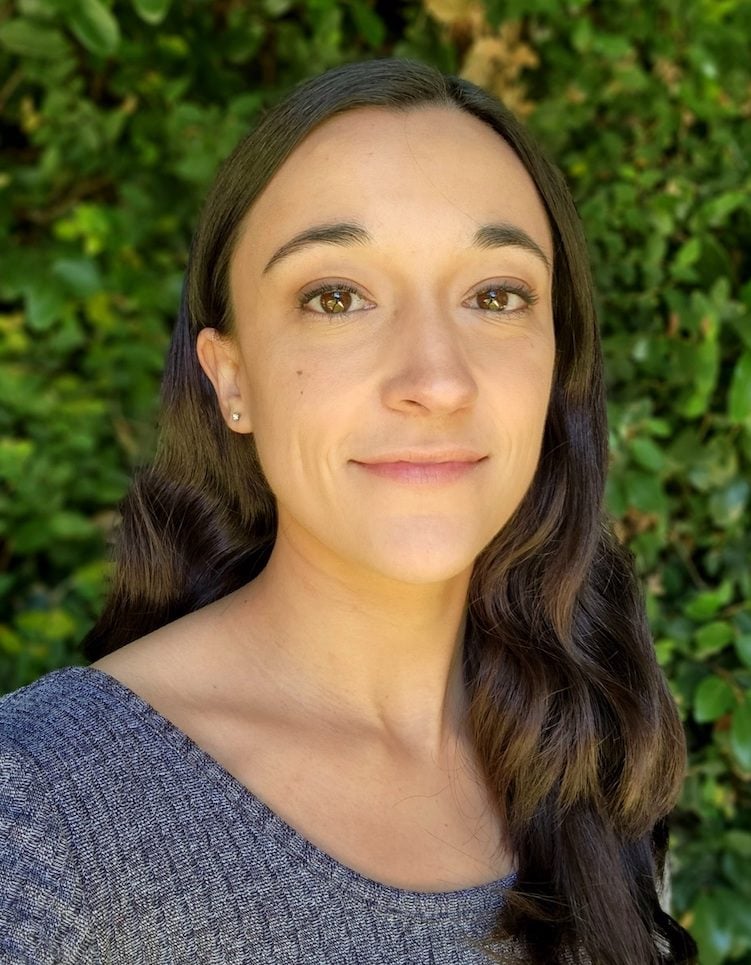
This is such an inspiring story of bravery and quick thinking! Elizabeth’s use of technology to save herself is a testament to how resourceful we can be in dire situations. It’s incredible to see how she turned her fear into action. Thank you for sharing her powerful journey!
Wow, Elizabeth’s story is truly inspiring! It’s incredible how she used her resourcefulness and quick thinking to find a way to communicate and ultimately save herself. Her courage in such a terrifying situation is commendable. Thank you for sharing her story!
What an incredible story of bravery and resourcefulness! Elizabeth’s quick thinking and use of technology are truly inspiring. It’s amazing to see how a simple text message can change the course of events in such a dire situation. Thank you for sharing her journey!